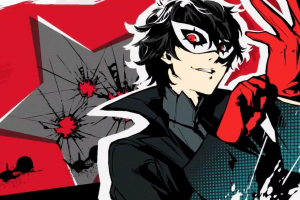 A while back, on the strength of great reviews, a delightful trailer and the promised of capers, I picked up an played Persona 5 on the PS4 (my primary video game console) and I loved it. Loved it loved it loved it. It is amazing how many of my buttons it hit. It had capers and style, but it also had time management and fun characters and entertaining dungeon crawls and great pacing and and and…
A while back, on the strength of great reviews, a delightful trailer and the promised of capers, I picked up an played Persona 5 on the PS4 (my primary video game console) and I loved it. Loved it loved it loved it. It is amazing how many of my buttons it hit. It had capers and style, but it also had time management and fun characters and entertaining dungeon crawls and great pacing and and and…
So I liked it. I liked it enough that I borrowed a copy of Persona 4 from a friend, and ended up enjoying it enough that I bought my own player. I also may have watched all the available anime.
I liked that enough that I dusted off my PS3 to install the PS2 emulated version of Persona 31 and despite the fact that it was a little bit of a pain in the ass (and the age of the game was showing) I enjoyed the hell out of that.
I am unlikely to go back much further. The technical limitations of the older games and the hoops I need to jump through to get them playing outstrip the benefits of just watching them on YouTube. I’m ok with that – these are now thoroughly embedded in my personal canon.
Obviously, I’ve put some thought into mapping them to RPGs. It would not be hard to capture their gameplay structurally by starting from Blades in the Dark – crew-centric, mission based play is right in the sweet spot, and it would just need tools for social links and dungeon crawling, which would not be a huge lift.
But despite that, the game that I have found myself thinking about when I get to the end of each of these is Mage: the Ascension.
Now, Mage is a fascinating game which is hard to talk about because by it’s nature, everyone who played mage played a different version of the game. Because the nature of the game was about the manipulation of subjective reality and the rules were designed to support anything, the game tended to be about whatever slice of that was most exciting to a particular group.2
For all that, the most fascinating part of Mage to me was the part it probably did least well.
So, in Mage, there’s an underlying, true reality which mages can understand and manipulate, and it’s represented by the various “spheres” (like death, life, mind, entropy etc.) that make up the building blocks of an experienced universe and which are also the mechanical components that drive the magic system.
But, fiction-wise, you don’t just jump to that understanding. That’s the underlying truth, but there are numerous magical traditions that lead to power, but are incomplete in their understanding. On paper, the arc of a mage in Mage is to discover power through, say, Hermetic Secrets, and use that power for a while before eventually reaching an understanding of the meta-truth behind everything (and then, with subsequent splats, to discover the meta-meta-truth, but that’s less interesting to me).
The problem, and I use the term loosely, was that the meta-truth was laid out very clearly to players and was essential to the workings of the system, so there was very little incentive to spend any time in that space of incomplete understanding excepting any point where the mechanics demanded it.3
To unpack a little, the Mage sphere system could be used to mechanically model almost any in-fiction effect. This was awesome, no question. And it meant if you started from fiction that you wanted to shoot a lightning bolt from your hand, you could determine that that was a Forces:3 effect, and you had all the mechanics you needed, and if you had Forces:3 on your sheet. And that’s great, but on your sheet you had “Forces:3” so it was easier (and more beneficial) to think in terms of “what can I do with my 3 dots of forces?”
None of these things were bad, but they pushed Mage into the meta game pretty fast unless you forcibly dragged it back. Whether that’s a bug or feature depended what you were shooting for.
Which brings us back to Persona. In each Persona game, it is revealed that there is a deeper layer of reality that most people cannot perceive, but which contains both power and threats which impact the real world and can be used by some handful of beings who have the awareness. It also suggests that there’s a deeper layer still, which the protagonist accesses, and the arc of the protagonists journey (which is the journey through the Major Arcana) involves a lot of monster fights, but also represents an arc that ends in deeper understanding of the true nature of the world.4
This delights me to no end, and is a big part of the reason that when I finish a Persona game, I kind of feel like I’ve just finished the best session 0 of a Mage game that I could possibly imagine.
- For the nerds who know enough to ask: I played Persona 4 Golden and Personal 3 FES. On 3, I completed The Journey, but I admit I just watched a YouTube of The Answer because there’s a reason I don’t play Dark Souls. ↩︎
- In contrast, Mage: The Awakening is much more about the things Mage said it was about, which is exactly why it was not Mage in many people’s eyes, so make of it what you will. I note, I really liked Awakening a lot, but it’s a different beast.
↩︎ - Mage 2e did a lot of things which, I think, had the intent of making this intermediate step more prominent, but at that point the genie was out of the bottle, so it felt punitive. Curiously, I would also argue that this is part of what made Technocracy stuff more playable because the Technocracy are more strictly tied to their model of the universe, because that’s rather the point. ↩︎
- This is more obvious in 4 and 5 – hell, 5 ends with with protagonist looking directly at the player. 3 is thematically similar but, of course, has a somewhat different arc. ↩︎
